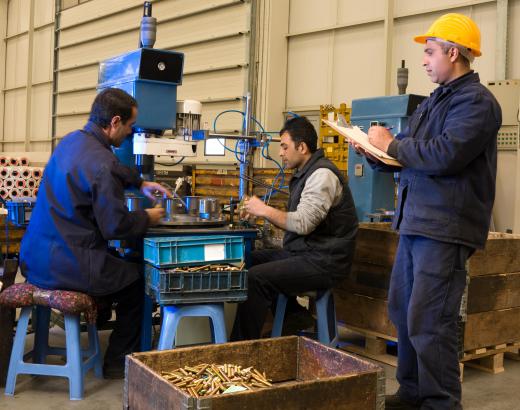The term “speeds and feeds” is a casual way of referring to the rates at which a mechanical tool cuts and at which material is fed into it. Speeds and feeds are variables that are of concern in a variety of machining techniques including milling, drilling, and turning. Cutting rate is the difference between the velocity of the tool and the surface of the work piece — whether it be wood, steel, or some other material — and is given in units of distance per unit of time. Feed rate is the distance the tool travels in the work piece for each revolution the tool makes, and is given in units of distance per revolution. As a form of shorthand, these measurements are sometimes be referred to as “feeds and speeds.”
Speeds and feeds for machining operations depend on a variety of factors. First among these factors is what particular type of machine is being used. The materials of both the tool and the work piece are other major variables and are among the most straightforward for the manufacturer to account for in recommendations. Once these aspects have been decided, it is a reasonably simple matter for the operator to quantify other variables, such as the depth of cut.

Milling is the process in which a rotating tool with teeth on one end is advanced into a work piece to remove material from. Modern milling machines can produce a variety of shapes by removing material in all three dimensions. Speeds and feeds in milling can depend on the diameter of the tool and the number of teeth it has.
Drilling advances a rotating bit with a sharp tip — and sometimes cutting edges — into a work piece to remove material, leaving a hole where the material was. The size of the drill bit is a factor in calculating cutting rate and feed rate for drilling operations. Generally, the speed of the drill bit lessens as the diameter of the needed hole increases. This is meant to avoid risk of burning out the drill’s motor. The depth of the hole being drilled also typically reduces the recommended values for these values.
Shaping an object by turning involves fixing its ends in a holding device that rotates it as a cutting tool is advanced into the work piece. Turning pieces of wood on a lathe in woodworking, for example, may produce items such as table legs, banisters, and bodies of lamps. The size and shape of the cutting tool used in turning are all factors that affect the recommended speeds and feeds for a lathe.
Manufacturers of machining tools may provide charts containing recommended values for cutting rates and feed rates. An operator may choose values based on information provided in professional handbooks and manuals for machining. Formulas are also available for various operations by which to estimate appropriate speeds and feeds. These values, however, are usually general guidelines and not exact specifications.
Speeds and feeds are also dependent on variables that are more difficult to quantify, such as sharpness of the tool, effectiveness of cooling of the operation, and others. They may need to be adjusted to account for such variations that cannot be specifically accounted for in the manufacturer’s recommendations. A good rule of thumb is to start with more conservative speeds and feeds and adjust them as necessary based on actual use. By operating at optimal levels, the operator can economize on manufacturing time while maximizing the life of the tool while at the same time producing a quality final product.
